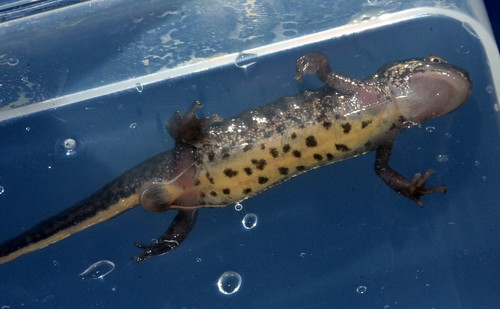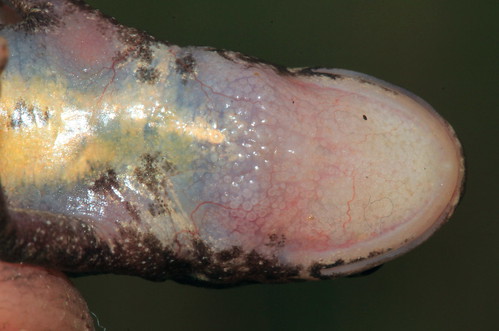Description
The palmate newt is a small species, males reaching only about 8.5 cm and females 9.5 cm. The base colour of both sexes is olive-green or brown, and a dark mask-like line runs across the head through the eyes; males and some females have a dark spotting on their backs.
The male has webbed hind feet and a low, smooth crest along the back that continues into a slightly higher crest on the tail, ending in a thread-like tip during the breeding season of April - May. Males can also have enlarged cloacal regions when close to breeding due to the spermatophores exerting pressure on the cloacal tissue. The crest and filament become less obvious and may disappear at other times when they become terrestrial. Males also have marked dorsolateral ridges, giving them a rather square cross-section. Females grow to 10 cm (4 in) and males to 8.5 cm (3.3 in). During the breeding season, they are active during the day, as well as night, but outside this period, activity is restricted to rainy or humid nights.
All of our newts are protected under the Wildlife and Countryside Act 1981, prohibiting trade in any of the three species. Declines have been observed in all three species, probably a result of the loss of many ponds across the UK
Habitat
All of our newts leave hibernation in February or March, returning to ponds for breeding. Weedy ponds without fish are favoured. Weeds provide refuge for newts as well as providing egg-laying locations - on the undersides of leaves. The distribution of palmate newts seems to be influenced by a preference for shallow, soft water pools on acid soils. For palmate newts and great crested newts it is also important to have undisturbed terrestrial habitat around the ponds, providing refuge and good feeding sites. Common newts seem less concerned by the quality of the surrounding habitat.
Common newts are the most terrestrial of the three species, often being found far from water during the summer, when the breeding season is over. Palmate newts also spend much of the summer in terrestrial habitats. Great crested newts spend most of their time around ponds, although a lot of this will be spent on the surrounding land rather than in the water. Outside of the breeding season all three newt species are nocturnal, taking refuge in damp environments such as burrows, compost heaps or under stones during the day. These are also prime hibernation sites for the winter months.
National Distribution Please Allow Time to Load
.
VC 63 Distribution Please Allow Time to Load



No comments:
Post a Comment